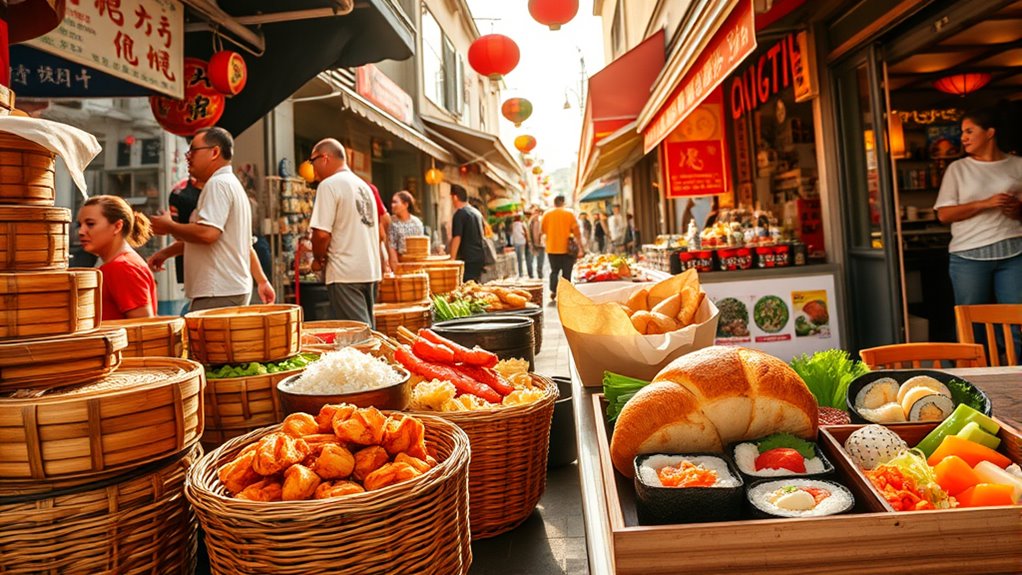Around the world, lunch customs reveal how cultures value social connections, tradition, and time. In Europe, late, leisurely meals often focus on savoring food and conversation, especially in Spain, Italy, and France. In Asia, quick yet balanced bento boxes and respectful dining manners are common, while Indian lunches emphasize communal sharing and spicy dishes. If you explore further, you’ll discover even more fascinating ways midday meals reflect each society’s unique identity.
Key Takeaways
- Lunch customs vary globally, reflecting cultural values, social norms, and historical traditions.
- European countries often emphasize leisurely, sit-down meals that foster social interaction and savoring.
- Asian lunch practices prioritize efficiency, balanced nutrition, and respect for food, with quick, thoughtfully prepared options.
- Indian midday meals highlight communal sharing, rich spices, and cultural importance of connection through food.
- Western routines tend to favor quick, convenient options during workdays, with some cultures maintaining relaxed, social lunch traditions.

Have you ever wondered how lunch traditions shape daily life around the world? It’s fascinating to see how different cultures approach this midday meal, reflecting their values, history, and social norms. In many places, lunch isn’t just about nourishment; it’s an essential part of community and work life.
Lunch traditions around the world reveal cultural values, social bonds, and everyday life.
For example, in Spain, the siesta culture influences a long, leisurely lunch often enjoyed between 2 and 4 p.m. It’s a time when families and friends come together to relax, share a meal, and pause from the busy day. This tradition underscores the importance of work-life balance and social connection, even if it means adjusting work schedules.
Similarly, in Italy, lunch is often a cherished event, typically lasting an hour or more, featuring multiple courses like pasta, salads, and fresh bread. It’s a time to unwind and enjoy good company, emphasizing quality over speed. The Italian approach highlights the cultural value placed on savoring food and fostering relationships.
Across Asia, lunch customs vary widely but often serve as an essential social or familial gathering. In Japan, many workers and students take a quick yet balanced lunch, like a bento box filled with rice, vegetables, and protein. It’s efficient but still thoughtfully prepared, reflecting a cultural respect for food and discipline.
Meanwhile, in India, lunch can be a vibrant affair, with dishes rich in spices like curries, rice, and bread. It’s often eaten with family or friends, emphasizing hospitality and communal sharing. In these cultures, lunch isn’t just sustenance; it’s a way to connect and maintain social bonds amidst busy schedules.
In Western countries like the United States and much of Europe, lunch tends to be quicker, especially during workdays. Many people grab sandwiches, salads, or fast food on the go. However, in some European countries like France and Italy, lunch remains a more relaxed affair, often involving sit-down meals that encourage conversation and enjoyment.
This variation shows how cultural attitudes toward time, food, and socializing influence midday routines. Whether quick or leisurely, lunch acts as an essential pause in the day, offering a moment to recharge physically and mentally.
Ultimately, lunch cultures reveal a lot about how societies value community, tradition, and balance. From lengthy family gatherings to quick bites at desks, the way people approach their midday meal shapes daily life in meaningful ways. It’s a reminder that food isn’t just about calories—it’s a reflection of cultural identity and social connection that can unify people across the globe.
Frequently Asked Questions
How Do Lunch Customs Vary Between Urban and Rural Areas?
You might notice that lunch customs differ between urban and rural areas. In cities, you often grab quick, convenience meals or eat at cafes because of busy schedules.
In contrast, rural communities tend to have longer, more traditional meals, sometimes shared with family or neighbors. These differences reflect lifestyle, work patterns, and available resources, shaping how and when people enjoy their midday break.
What Are the Traditional Etiquette Rules for Lunch in Different Countries?
When you’re dining in different countries, it’s important to follow local etiquette. For example, in Japan, you should say “Itadakimasu” before eating and use chopsticks properly.
In France, keep your hands on the table and don’t rush your meal.
In the US, casual manners are common, but always say “please” and “thank you.” Respecting these customs shows appreciation and helps you enjoy your meal authentically.
How Has Globalization Influenced Local Lunch Traditions Worldwide?
Globalization acts like a bridge, blending vibrant local lunch traditions with international influences. You might see sushi alongside sandwiches or traditional dishes served with global flavors.
This fusion enriches your dining experience, making lunchtime more diverse and exciting. While some cherish authentic customs, others embrace new trends.
You’re part of this dynamic change, where local and global collide, creating a colorful mosaic of midday meals that reflects the interconnected world you live in.
Are There Specific Health Considerations in Various Lunchtime Cultures?
When you explore lunchtime cultures, you’ll notice health considerations vary widely. Some cultures prioritize balanced, nutrient-rich meals, while others focus on lighter, quicker options.
You should be mindful of portion sizes, ingredients, and preparation methods, as they impact your health. Opt for fresh vegetables, lean proteins, and whole grains when possible.
Being aware of these differences helps you make healthier choices, no matter where you’re or what traditions you follow.
How Do Work Schedules Impact Lunch Timing Across Cultures?
They say, “Time waits for no one,” and in many cultures, work schedules shape lunch timing.
You might find that in some countries, lunchtime aligns with a midday break, while in others, it’s later or shorter.
Your work hours influence when you eat, often reflecting local customs and productivity patterns.
Adapting to these schedules helps you stay energized and culturally connected, even if your lunch hour varies.
Conclusion
As you explore lunch cultures worldwide, you’ll see how midday meals reflect each society’s values and traditions. For instance, imagine a company in Spain implementing a siesta-inspired break, boosting employee happiness and productivity. By understanding these diverse customs, you can appreciate the rich tapestry of global traditions and even incorporate some into your own routine. Embracing this variety enriches your perspective, reminding you that lunchtime is more than just a meal—it’s a window into culture.









